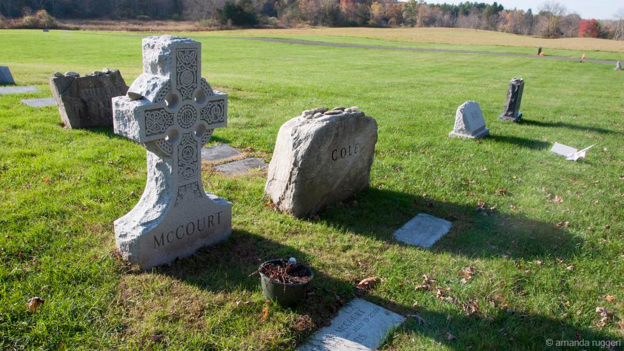玛丽莲·梦露的隐秘故居 - BBC阿曼达·鲁杰里(2023年6月14日)

老托菲特路(图片来源:阿曼达·鲁杰里)
在美国的康涅狄格州,有一个名叫罗克斯伯里(Roxbury)的小镇,它隐藏在郁郁葱葱的树林和高低起伏的农田之中,石墙和谷仓随处可见。这里距离纽约虽然只有75英里,但却仿佛来自两个世界,与好莱坞更是毫不搭边。
虽然这个始建于18世纪初的小镇只有区区2300名居民,但这里却云集众多文艺界的大腕明星,包括演员丹尼尔·戴-刘易斯(Daniel Day-Lewis)、《欲望都市》作者坎迪斯·布什奈尔(Candace Bushnell)、作曲家斯蒂芬·桑德海姆(Stephen Sondheim)、记者盖伊·塔利斯(Gay Talese)、演员约瑟夫·戈弗雷(Joseph Godfrey)和《名利场》编辑格雷顿·卡特(Graydon Carter)。这座小镇已故的居民还包括作家弗兰克·麦考特(Frank McCourt)、小说家威廉·斯泰伦(William Styron)、雕塑家亚历山大·卡尔德(Alexander Calder)、演员沃尔特·马修(Walter Matthau)和理查德·韦德马克(Richard Widmark)、编剧汤姆·科尔(Tom Cole)和戏剧家亚瑟·米勒(Arthur Miller)。
然而,这些人的名气都比不上罗克斯伯里最著名的居民:玛丽莲·梦露(Marilyn Monroe)。
除了利奇菲尔德县(Litchfield County)的居民外,很少有人知道梦露曾于1956至1961年居住在康涅狄格州的这座小镇,很多人甚至从未听说过罗克斯伯里这个地方。为了迎接周末前来度假的人们,周围的很多小镇都修建了各种做作的餐厅和古朴的民宿。但罗克斯伯里却依然保持着难得的宁静,这里的房价中值为609,200美元,在康涅狄格州名列前茅。小镇的中心很简陋,只有一个小镇文书官办公室、一个梦露常去的小市场和一座加油站,还有一处墓地——米勒和麦考特等人都安葬于此。我之所以知道罗克斯伯里,是因为我在附近的镇上读过高中,我的家人至今仍住在那里。
也正因如此,我最近才专门抽出一个周末来到了罗克斯伯里,做了一件我从未想过要做的事情:追溯梦露和米勒在当地留下的种种痕迹——在20世纪50年代,他们或许是荧屏之外最迷人的一对夫妇。
当梦露1956年6月与米勒结婚时,她已经凭借1953年的《绅士爱美人》(Gentlemen Prefer Blondes)和1955年的《七年之痒》(The Seven-Year Itch)等影片俘获了无数影迷的心,堪称世界头号明星。然而,就是在那时,梦露也开始逐渐逃离浮华世界。“我恨好莱坞,”她在结婚时对米勒说,“我想在一个小镇里静悄悄地生活,在你需要我时守在你身边。”
米勒是一位剧作家,他最著名的作品当属《推销员之死》(The Death of a Salesman)。而在朋友眼中,他又是一个热衷田园风情的隐士,清田整地和园艺栽培都是他的最爱。米勒1947年搬到罗克斯伯里,而在1957年与劳伦斯·奥利维尔(Laurence Olivier)合作的电影《游龙戏凤》(The Prince and the Showgirl)上映后,梦露也随同米勒来到了位于老托菲特路(Old Tophet Road)的这套四居室的农舍。

罗克斯伯里著名居民的长眠之地(图片来源:阿曼达·鲁杰里)
多年以来,麦考特、马修、韦德马克和科尔等很多名人也都曾在这条路上定居过。彼得·哈尔布特(Peter Hurlbut)既是罗克斯伯里的镇书记,也是该镇创始人的后裔,他说:“沿着斯坦福德的‘富豪街’开车,你肯定知道自己身在‘富豪街’。但在这里,你绝不会有这种感觉。”
他说的没错。老托菲特路距离小镇的中心大约10分钟的车程,但实际的感受却不止这点距离。十月的时候,沿着狭窄而蜿蜒的道路前进,你会感觉自己穿过了一条五光十色的树叶隧道。道路两旁散落着废弃的谷仓和殖民地风格的房屋。如果不是事先知道米勒等文人墨客曾在这里居住,我绝不会注意到这条道路——与此类似的道路在康涅狄格的这一带随处可见。

梦露故居(图片来源:阿曼达·鲁杰里)
周围的房子都很相似,米勒的故居在其中毫不起眼,我们从它前面经过时甚至完全没有察觉。白色的外墙,浅绿色的百叶窗,那栋房子就那样安静、优雅地矗立着,与周围其他殖民地风格的居所别无二致。不过,当你真的从它面前驶过时,会发现它还是很容易辨识的。我透过浓密的树林窥视着它,努力想象着它在20世纪50年代的样貌——彼时,这处房子定然是狗仔队们经常光顾的“乐园”。1956年,就在梦露与米勒领取结婚证的那一天,在众多尾随他们的汽车中,有一辆因为在蜿蜒的小路上车速过快而发生事故,导致车上的一名法国记者身亡。
迷信的人或许会将那次车祸视作一个不祥的征兆。梦露想必曾对康涅狄格的田园生活抱有无限的遐想,也定然对这个小镇和米勒所能给予她的静谧满怀憧憬,但现实很快打破了她的幻想。就连这栋房子本身也暴露出他们之间的差异:梦露和米勒最初计划拆掉这栋老旧的农舍,在原址上兴建一栋新的房子。但当米勒向弗兰克·劳埃德·赖特(Frank Lloyd Wright)了解设计方案时,梦露这位向来以朴素著称的新丈夫却难以接受如此豪华的居所。于是,那份宏伟的计划被迫搁浅。18世纪的这栋农舍得以保留至今。
回到罗克斯伯里,我在梦露常去的小市场Roxbury Market & Deli里停留了片刻。里面有几条走道,可以买到当地人制作的果酱和日常主食,这恐怕是整个罗克斯伯里最接近杂货店的地方了。不难想象,梦露曾经在这里努力扮演家庭主妇的角色。同样不难想象的是,这样一位习惯了长枪短炮和阿谀奉承的好莱坞巨星,肯定会很快厌倦这样的生活。

径路交错的森林(图片来源:阿曼达·鲁杰里)
毕竟,罗克斯伯里是一个宁静的地方。除了欣赏镇上的殖民风格建筑和尖塔形的教堂外,这里最吸引人的莫过于森林。罗克斯伯里土地信托(Roxbury Land Trust)拥有2,575公顷径路交错的自然保护区,很多土地都来自曾在这里居住的名人:这里有32公顷马修保护区、22公顷斯泰伦保护区、27公顷韦德马克保护区,当然,还有55公顷亚瑟和英格莫拉斯·米勒保护区。
这确实是个宁静的小镇。然而,对于梦露这种一举一动都能引发公众关注,同时又不停地咒骂这种浮华生活的巨星而言,这里却并非理想的归处。米勒似乎也不是她的理想伴侣。1961年,他们二人离婚。19个月后,梦露与世长辞。
米勒的余生都在罗克斯伯里度过,他经常跟弗兰克·麦考特和米亚·法罗(Mia Farrow)一起打网球,法罗至今仍住在附近的一座小镇。2005年,米勒去世,享年89岁。

Mamie's的薄煎饼(图片来源:阿曼达·鲁杰里)
罗克斯伯里有一家别处没有的餐馆,名叫Mamie's。我在这家餐馆要了一份蓝莓薄煎饼,上面抹了枫糖酱。坐在木制的桌子上,远眺着色彩鲜艳的树木镶嵌在舍帕格河(Shepaug River)两岸。店主告诉我和母亲,这家店是7年前开张的。当我提到梦露和其他曾经居住于此的名人时,她点了点头,露出笑容。“米亚·法罗昨晚刚刚来过这儿。”她说,“丹尼尔·戴-刘易斯经常来,他人也特好。”
但我真正感兴趣的是米勒。然而,对于一个外人来说,除了看看他的故居或者到米勒保护区徜徉一番,似乎没有多少可以了解米勒的途径。
但米勒不仅死在罗克斯伯里,他甚至特意叮嘱人们把他葬在这里。在哈尔布特与米勒的最后几次对话中,这位剧作家曾经专门给他打过一次电话,非常好奇自己死后的墓碑将从何而来。哈尔布特替自己的父亲解释说,他们会用一块旧石头制作墓碑。俭朴的米勒很欣赏这个想法。他想知道石头将从何而来。哈尔布特说,他们会从当地的石墙遗址选取石料,他相信米勒肯定能找到一块自己喜欢的石头。几周后,米勒又给他打来电话。“我找到了!我找到石头了!”他说,那块石头来自他私人土地上的石墙。
于是,他就这样下葬了。他的墓碑很有可能来自几十年,甚至几百年前在他钟爱的土地上搭建的一堵石墙。在小镇文书官办公室附近的墓地里,米勒的坟墓紧靠着他的好友麦考特,简朴而充满乡土气息。我站在他的墓前,想起了哈尔布特说过的一句话。
“这里不是第五大道,也不是比佛利山庄,”他对我说,“但要打败这个地方却绝非易事。”
他说的没错。像米勒一样已故和在世的作家和文艺家也都会认同这种说法。我只是希望,梦露也曾在这里得到过些许慰藉——哪怕只有片刻。
(责编:友义)
The town that couldn’t contain Marilyn Monroe - By Amanda Ruggeri
Hidden among thick trees and hilly farmland, looped with stone walls and studded with red barns, the Connecticut town of Roxbury is 75 miles and a world away from New York City – not to mention Hollywood.
And yet the tiny town (pop 2,300), which was settled in the early 18th Century, is home to a plethora of artistic residents, including actor Daniel Day-Lewis, Sex and the City writer Candace Bushnell, musical composer Stephen Sondheim, journalist Gay Talese, actor Joseph Godfrey and Vanity Fair editor Graydon Carter. At one point, all three stars of the US television series Rescue Me – Jerry Adler, Michael Lombardi and Dennis Leary – lived in Roxbury simultaneously. The town’s late residents have included writer Frank McCourt, novelist William Styron, sculptor Alexander Calder, actors Walter Matthau and Richard Widmark, screenwriter Tom Cole and playwright Arthur Miller.
But none of those names compare to Roxbury’s most famous resident: Marilyn Monroe.
Few people outside of Litchfield County know that Monroe lived in the tiny Connecticut town from 1956 to 1961 – or have heard of Roxbury at all. Even as other nearby towns have welcomed weekenders with cutesy bistros and pristine B&Bs, Roxbury has remained quiet (and with a median house price of $609,200, one of Connecticut’s most expensive). The centre of town is little more than the clerk’s office, a small market and gas station where Monroe used to shop, and a cemetery where Miller and McCourt, among others, lie buried. I only know of Roxbury because I attended high school in the next town over, where my family still lives.
That’s how I found myself in Roxbury on a recent weekend, doing something I’d never thought to do before: track down local traces of Monroe and Miller, perhaps the most fascinating off-screen couple of the 1950s.
When Monroe married Miller in June 1956, she’d already captivated audiences in movies like 1953’s Gentlemen Prefer Blondes and 1955’s The Seven-Year Itch. She was the world’s biggest star. She was also beginning to fray from it. “I hate Hollywood,” she told Miller when they married. “I want to live quietly in the country and just be there when you need me.”
Miller, the playwright famous for The Death of a Salesman – and among friends, also for his love of rural pleasures such as field clearing and gardening – had moved to Roxbury in 1947. And so, after wrapping the 1957 movie The Prince and the Showgirl with Laurence Olivier, Monroe returned with Miller to his four-bedroom farmhouse on Old Tophet Road.
Over the years, the road became host to a number of other famous residents: McCourt, Matthau, Widmark and Cole among them. Yet you’d never know it. “Go to Stamford and drive down ‘millionaire’s row’, and you know you’re on millionaire’s row,” said Peter Hurlbut, the town clerk and descendant of Roxbury’s founder. “Here, you never know you’re on millionaire’s row.”
He was absolutely right. Old Tophet Road was a 10-minute drive from the centre of town, though it felt like longer. Narrow and winding, driving the route on an October day felt like heading through a psychedelically coloured foliage tunnel. Dilapidated barns and colonial houses dotted the land on either side. If I hadn’t known it was where Miller and other literati lived, I never would have made note of the road at all. In this part of Connecticut, streets like these are unremarkably common.
As are houses like Miller’s – so much so that we drove past it before realising. A lovely white clapboard with baby-blue shutters, the abode looked like any of the other quietly graceful colonials in the area. Peeking through the trees up the drive – the home is pretty recognizable when driving by – I tried to imagine what it would have been like in the 1950s, when the home became a paparazzi playground. On 29 June 1956, the same day that Monroe and Miller signed their marriage license (itself given by Hurlbut’s grandfather, then the town clerk), one of the cars following them was driving too fast on the winding country roads and crashed, killing the French reporter inside. In the press conference that the newlyweds gave at the farm, talking about the crash, their nuptials and on Senator Joseph McCarthy’s naming of Arthur Miller as a communist in the House Committee on Un-American Activities, Monroe appeared visibly upset; it was a rare crack in her star facade.
Those who believe in such things could have seen the crash as an omen. The fantasies Monroe must have had about living in Connecticut, and the peace that it, and Miller, would bring her, soon wore thin. Even the house itself showed their clash of priorities: the two had first planned to tear down the old farmhouse and build another one on the property. But when Miller asked for a design from Frank Lloyd Wright, one that turned out to be far too grand for her notoriously frugal new husband, the over-the-top plans were dashed. The 18th-century farmhouse stayed.
Back in Roxbury, I stopped at the little Roxbury Market & Deli, where Monroe did her shopping. With a few aisles of locally made jams and everyday staples, it’s the closest thing the town has to a grocery store. One can imagine her attempting to play the role of housewife here. One can imagine, too, how bored the Hollywood star, so accustomed to cameras and adulation, quickly became.
Roxbury, after all, is a peaceful place. Aside from admiring the town’s colonial houses and steepled churches, its biggest draw may be its forests. The Roxbury Land Trust maintains 2,575 acres of trail-crossed nature preserves, much of its land given by the same icons who lived here: there is the 32-acre Matthau Preserve, the 22-acre Styron Preserve, the 27-acre Widmark Preserve and, yes, the 55-acre Arthur and Inge Morath Miller Preserve.
A peaceful town, yes. But for someone like Monroe, who thrived on public attention as much as she reviled it, it wasn’t the right fit. Nor, it seems, was Miller. The two divorced in 1961. Nineteen months later, Monroe died.
Miller lived out the rest of his days in Roxbury – playing tennis with Frank McCourt and Mia Farrow, who still lives in the next town over, tinkering with his plumbing, clearing fields and, of course, writing. He passed away there in 2005 at the age of 89.
At Roxbury’s only restaurant, Mamie’s (the cafe-deli at the market aside), I had blueberry pancakes with maple syrup at one of the wooden tables, overlooking the brightly coloured trees that bordered the Shepaug River outside. The owner told my mother and I that she’d opened the restaurant seven years ago. When I mentioned Monroe and the others who had made the tiny town home, she nodded, smiling. “Mia Farrow was just in here last night,” she said. “And Daniel Day-Lewis is in here all the time. He’s the nicest guy, too.”
Miller, though, was the one I’d come to trace. And for an outsider, there weren’t many ways, apart from catching a glimpse of his house or walking through the Miller Preserve.
But Miller hadn’t just died in Roxbury. He’d also asked to be buried here. In one of Hurlbut’s last conversations with the writer, Miller had called him up, especially curious about how to get a tombstone in the case of his death. Hurlbut explained that for his father, they’d opted to create a tombstone from an old stone they’d found. The frugal Miller liked that idea. And where do you find one, he wanted to know. In the land of stone walls, Hurlbut said, he was sure Miller could find a stone he liked. A few weeks later, Miller called him back up. “I found it! I found the stone!” he said. It was from one of the walls on his property.
That’s how he was buried: with a stone, likely from a wall assembled decades, if not centuries, earlier, taken from his own property that he’d loved so much. At the cemetery next to the town clerk’s office, I stood in front of Miller’s rustic, unassuming-looking grave, next to his friend McCourt’s. And I remembered something else Hurlbut had said.
“It’s not Fifth Avenue or Beverly Hills,” he’d told me. “But you have to go a long way to beat this place.”
He was right. And past and present writers and artists like Miller must have agreed. I just hoped that Monroe, if only for moments at a time, had found a little bit of solace here too.